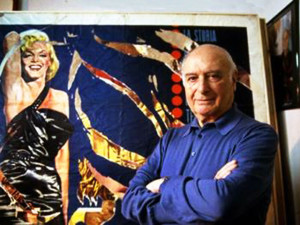
Mimmo Rotella
|
|
Born in Catanzaro in 1918, After middle school he moved to Naples to undertake artistic studies, in 1941 he moved to Rome. He stays in the capital only for a short time, because he is called to arms. In '44 he left the army and obtained a diploma from the Art School of Naples. Between 1944 and 1945 he taught Drawing in Catanzaro. In 1945 he was back in Rome and, after his figurative beginnings and the first experiments, he began to paint neo-geometric paintings. He began to participate in exhibitions in 1947, with the Trade Union Exhibition of Figurative Arts and with the annual ones of the Art Club. criticism. In 1951 he had a first contact with French art by exhibiting in Paris at the Salon des Realistés Nouvelles. Between 1951 and 1952, he obtained a scholarship from the Fullbright Foundation, which allowed him to travel to the United States as an "Artist in Residence" at the University of Kansas City. Also in 1952 he made his second solo show at the Rockhill Nelson Gallery in Kansas City. In the United States he has the opportunity to meet representatives of the new artistic currents: Robert Rauschenberg, Oldenburg, Twombly, Pollock and Kline. In 1953, he suffers from a crisis, during which he interrupts his pictorial production. Now convinced that there is nothing more to be done in art, he suddenly has what he calls "Zen illumination": the discovery of the advertising poster as an artistic expression of the city. Thus was born the décollage (at the beginning collage): he pastes on the canvas pieces of posters torn in the street, adopting the Cubist collage and contaminating it with the Dadaist matrix of the ready-made. In 1955, in Rome, in the exhibition "Current art exhibition", he exhibited for the first time the 'torn poster'. Then, he practices the so-called double décollage: the poster first detached from the billboard, then torn in the laboratory. In those years he also used the back of affiche, using the posters from the glued side and obtaining non-figurative and monochrome works. The first awards come in 1956 with the Graziano Award and in 1957 with the Battistoni and Public Education Award. With the Cinecittà series, from 1958, he selects figures and faces from film advertisements, orienting production towards works of a more figurative type. At the end of the 1950s, Rotella was labeled by critics as a poster ripper. At night, he tears not only posters, but also pieces of sheet metal from the frames of the billposting areas of the Municipality of Rome. In 1958 he received a visit to Rome from the French critic Pierre Restany, with whom he began a long association. In the same year he participated in Rome in the exhibition "New trends of Italian art" organized by Lionello Venturi at the Rome - New York Art Foundation headquarters. Also in 1960 he joined the Nouveau Réalisme, the theorist of which he is Pierre Restany and which brings together, among others, Klein, Spoerri, Tinguely, César, Arman and Christo. Also taking part in the group are the French Hains, Dufrêne and Villeglé, who work on décollage in the same years, but independently. Along with the décollages, Rotella also performs assemblages of objects purchased from second-hand dealers such as bottle caps or ropes. American Pop Art and Abstract Expressionism, together with the Informal and the spatial and material researches that Fontana and Burri were carrying out in Italy in those years, played an important role in Rotella's orientation. In 1961 he exhibited in the historic exhibition À 40 ° au-dessus de Dada, curated in Paris by Restany. In 1962 he conferred on his art at the School of Visual Arts in New York and in 1964 he was invited to the Venice International Art Biennale. Using typographic tools, between 1967 and 1973 he created the Art-typo, prints chosen and freely reproduced on the canvas. With this procedure he manages to overlap and overlap the advertising images, reversing the previous way of proceeding. Definitely left Paris to settle in Milan (1980), in the eighties he elaborated the "blanks" or affiches covers: canceled advertising posters, covered with white sheets, as happens with expired advertising. After 1986 he realizes the overpaintings, inspired by graffiti: he intervenes pictorial on torn posters pasted on canvas. It traces anonymous writings, such as those that can be read on city walls: love messages, political writings, etc., in a double message. In 1990 he took part in the "Art et Pub" exhibition at the Center Pompidou in Paris and in the "High and Low" exhibition at the Museum of Modern Art in New York. In 1992 he received the title of Officiel des arts et des Lettres from the French Minister of Culture, Jack Lang. In 2000, by the artist's will, a foundation dedicated to him was established: the Mimmo Rotella Foundation, with the aim of collecting the works and cataloged documentation of the master's artistic life. He passed away in Milan in January 2006. |
